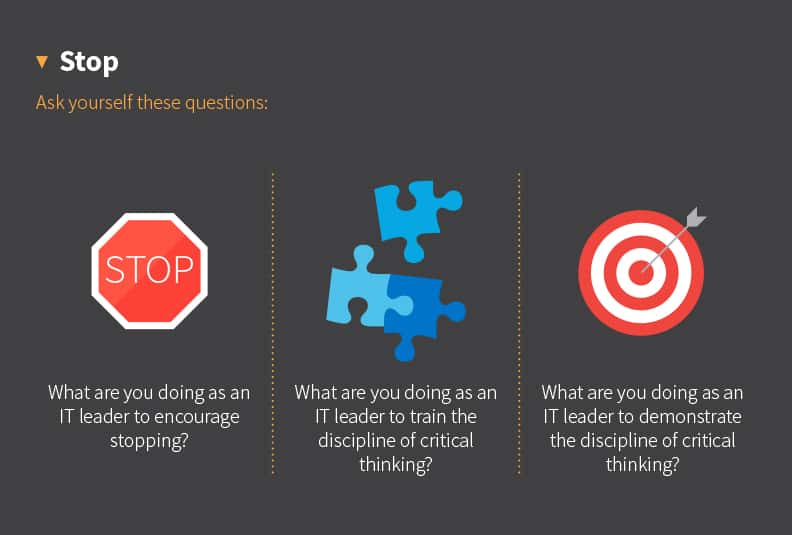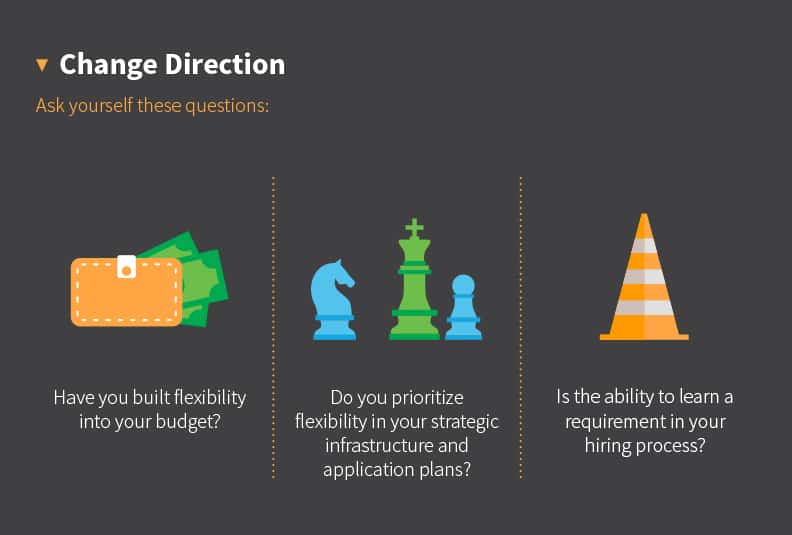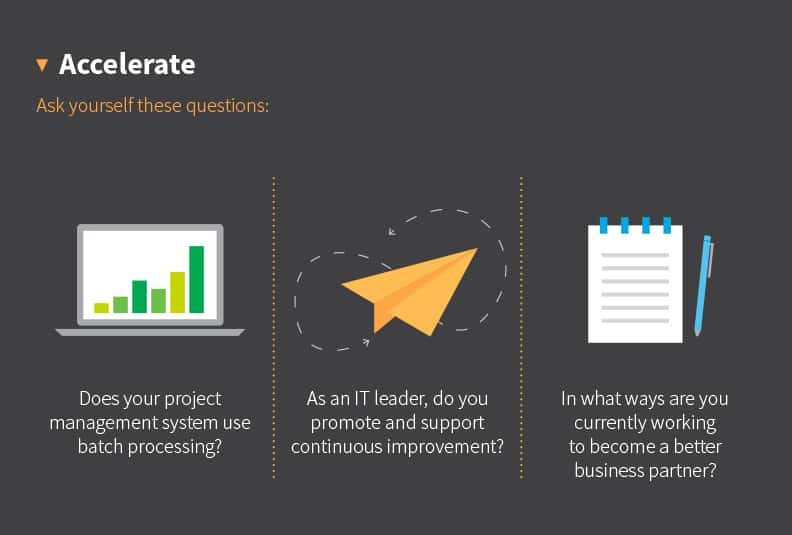Introduction
With good reason, “agility” is a buzzword in the modern Information Technology world.
The unrelenting rate of change increases the pressure businesses feel to keep up. The IT department is tapped to provide the platform from which the business can adjust, adapt and anticipate its next move. To be successful in that effort, IT professionals need to understand how agile IT management – as both individuals and teams – can launch success.
What do we mean by agile IT management?
By not fully understanding the fundamental concept of agile IT management, many IT leaders fail to develop agile individuals and teams who are adaptable to change. Instead, leaders direct their teams to work faster while measuring the time it takes to complete a task. However, speed alone is not agile IT management. Rather, agility should be viewed as the ability to stop, change direction and accelerate. All three actions are key to building an agile IT department.
How to implement an agile IT management plan
1. Stop
In today’s world, stopping may be the most difficult step to achieving agility.
IT culture is wired to take constant action, with a tendency to reward employees based on the volume of tasks completed rather than recognising vital tasks that directly impact organisational objectives. The IT professionals who do strategise which tasks to focus on risk being labelled slow or indecisive.
In his book A More Beautiful Question, Warren Berger argues that people need to stop taking constant action and start asking more questions. Specifically, leaders should ask why, what if and how, in that order. Glossing over or rushing through any of these questions cheats an IT leader of the self-reflection needed to fully understand a problem, dream of a new possibility and strategically plan for that possibility.
The former CEO of Steelcase, Jim Hackett, asked: “When did the balance between thinking and doing get out of equilibrium?”
In recognition of the “over-celebration of getting things done,” Hackett used agile IT management by role modelling and formal courses to teach his team critical thinking, which played a large part in turning the company around.

2. Change Direction
While the first step in implementing agile IT management is to set clear expectations for an agile culture and mentality, the second step focuses on agility in IT processes and infrastructure.
Just as the design of a ship affects its ability to change direction, the design of the IT system effectively determines an IT team’s ability to change direction as needed.
One way to plan for quick directional changes is to build flexibility into the IT budget. As mentioned in our article “Three Budget Challenges of IT Leaders,” it is important to consider vendors who offer customisation and cancellation options in their agreements. These vendors provide flexibility and allow IT leaders to allocate resources to areas of need as they arise.
Another way to promote agility is the creation and implementation of a comprehensive “flexibility first” infrastructure and architecture plan. Many companies are equipping their plans with virtualisation strategies that include public clouds, private clouds, hybrid clouds and software-defined data centres.
These agile strategies allow new images and applications to be quickly spun up anywhere within the IT infrastructure, instead of the slower model of building hosts. Similarly, Gartner advocates the use of a bimodal IT approach that allows the organisation to split itself into two modes of IT – one traditional and one agile – until it has the capacity to move entirely to the agile IT management mode.
Each company’s strategic approach will require its own unique plan that takes into account the organisation’s objectives, size, structure and needs.
Ultimately, to build an agile IT infrastructure that is able to adapt to change requires the right human capital. IT leaders must hire professionals with the capability to address change successfully. Each IT member is continually called upon to learn new systems, new modes of operation and even new ways of thinking. Identifying current and future goals, implementing new solutions and consistently delivering innovative service is the standard for agile IT management.

3. Accelerate
The third step of an agile IT management approach is helping the team to reach full productivity and utilising the benefits of a new technology as soon as possible.
An important element of quick acceleration in agile IT development is project management. There are many theories on how to approach it. IT teams may implement a “scrum” system, advocating the use of short time-frames called sprints during which deliverable projects are created and then improved upon in subsequent sprints. Other teams use hybrid “agile” IT management mentalities that utilise high levels of communication and prioritisation. Regardless of method, the key concept of batch processing is the same. People are most effective when they focus on only one task at a time. Project management should help employees to narrow their focus to tackle one issue at a time.
Quick acceleration in agile IT management also requires continuous improvement to help to identify areas of any system that are not working well and make corrections to eliminate bottlenecks and waste. Since continuous improvement is an ongoing effort, each improvement builds on the last and creates exponential efficiency.
Six Sigma and Lean Production are two well-known approaches to continuous improvement for IT professionals. The support of colleagues is another element that has a significant impact on acceleration. An IT leader will have access to the resources and information necessary to move more quickly towards the goal with the backing of their colleagues. We address creating greater support and understanding in the article “Five Ways a CIO can Become a Better Business Partner”.

Conclusion
By building the correct platforms, IT teams add the capability of other departments to drive value and respond to changing business dynamics through agile IT management.
IT is tasked with equipping the organisation with the right systems and infrastructure to be able to respond to changing business demands effectively at every turn. Only by maximising team agility will IT leaders be able to keep pace with multiple challenges and implement the best technology solutions. Using the simple model of stop, change direction and accelerate can help IT leaders to empower their teams and their organisations to engage successfully with the constant change in our world.
Topics:




